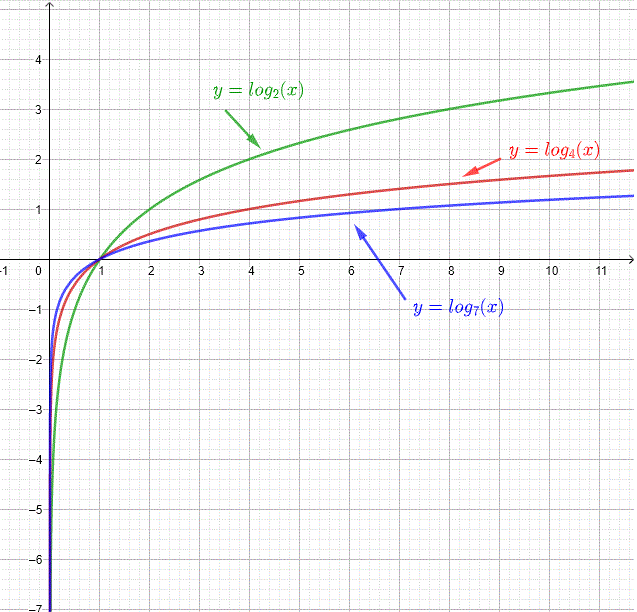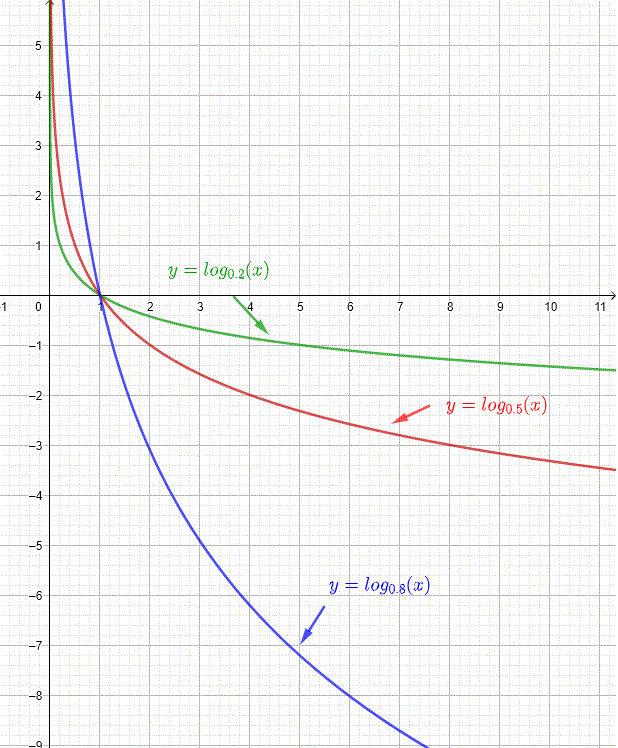Definition of Logarithmic Functions
The logarithmic function with base B is defined as the inverse of the exponential function of base B as follows
For \( B \gt 0 \) and \( B \ne 1 \)
\[ y = \log_B(x) \;\;\; \text{ if and only if } \;\;\; x = B^y \]
Note: The logarithm to the base e is called natural logarithm and written as \( \ln(x) \).
The domain of \( y = \log_B(x) \) is the set of the real positive numbers given by the inequality \( x \gt 0 \) or by the interval \( (0 , +\infty) \)
Evaluate and Graph Logarithmic Functions
One way to manually evaluate logarithms is to use the relationship between the logarithm and exponential functions given above. The real numbers y, B and x are related by the logarithm and the exponential. The logarithm is the power in the exponential form.
Since \( 2^4 = 16 \) , then \( \log_2(16) = 4 \)
Since \( \sqrt(9) = 3 \) which can be written as \( 9^{(1/2)} = 3 \) , then \( \log_9(3) = 1/2 \)
Since \( B^0 = 1 , B \ne 0 \) , then \( \log_B(1) = 0 \)
Example 1: Table of values and graphs of logarithmic functions with base greater than 1
A table of values and the graphs of the logarithmic functions \( \log_2(x)\), \( \log_4(x)\) and \( \log_7(x) \) are shown below
| \( x \) | \( \log_2(x) \) | \( \log_4(x) \) | \( \log_7(x) \) |
| \( 0.00000001 \) | \( -26.5754 \) | \( -13.2877 \) | \( -9.4663 \) |
| \( 0.001 \) | \( -9.9657 \) | \( -4.9828 \) | \( -3.5498 \) |
| \( 0.01 \) | \( -6.6438 \) | \( -3.3219 \) | \( -2.3665 \) |
| \( 0.1 \) | \( -3.3219 \) | \( -1.6609 \) | \( -1.18329\) |
| \( 0.5 \) | \( -1 \) | \( -0.5 \) | \( -0.3562 \) |
| \( 1 \) | \( 0\) | \( 0 \) | \( 0 \) |
| \( 2 \) | \( 1 \) | \( 0.5 \) | \( 0.3562 \) |
| \( 100 \) | \( 6.6438\) | \( 3.3219 \) | \( 2.3665 \) |
| \( 1000 \) | \( 9.9657 \) | \( 4.9828 \) | \( 3.5498 \) |

Example 2: Table of values and graphs of logarithmic functions with base less than 1
A table of values and the graphs of the logarithmic functions \( \log_{0.2}(x)\), \( \log_{0.5}(x)\) and \( \log_{0.8}(x) \) are shown below
| \( x \) | \( \log_{0.2}(x) \) | \( \log_{0.5}(x) \) | \( \log_{0.8}(x) \) |
| \( 0.00000001 \) | \( 11.4454 \) | \( 26.5754 \) | \( 82.5508 \) |
| \( 0.001 \) | \( 4.2920 \) | \( 9.9657 \) | \( 30.9565 \) |
| \( 0.01 \) | \( 2.8613 \) | \( 6.6438 \) | \( 20.6377 \) |
| \( 0.1 \) | \( 1.4306\) | \( 3.3219 \) | \( 10.3188\) |
| \( 0.5 \) | \( 0.4306 \) | \( 1 \) | \( 3.1062\) |
| \( 1 \) | \( 0\) | \( 0 \) | \( 0 \) |
| \( 2 \) | \( -0.4306 \) | \( -1 \) | \( -3.1062 \) |
| \( 10 \) | \( -1.4306 \) | \( -3.3219 \) | \(-10.3188 \) |
| \( 100 \) | \( -2.8613 \) | \( -6.6438 \) | \( -20.6377 \) |
| \( 1000 \) | \( -4.2920 \) | \( -9.9657 \) | \( -30.9565 \) |

Properties of the logarithmic functions
From the above values and graphs we conclude the following properties
1) The domain of any logarithm function of the form \( f(x) = log_B(x) \) is the set of all real positive numbers. In inequality form the domain is: \( x \gt 0 \) and in interval form it is given by: \( (0 , +\infty) \).
2) If \( B \gt 1\), the logarithm function \( f(x) = \log_B(x) \)
increases as x increases which may written using the limits as: \( \lim_{x \to +\infty} f(x) = + \infty \)
and
takes smaller and smaller vales as x approaches zero from the right, which may be written using limts as: \( \lim_{x \to 0^{+}} f(x) = -\infty \)
3) If \( 0 \lt B \lt 1\), the logarithm function \( f(x) = \log_B(x) \)
approaches \( -\infty \) as x increases which may written using the limits as: \( \lim_{x \to +\infty} f(x) = -\infty \)
and
takes larger and larger vales as x approaches zero from the right, which may written using the limits as: \( \lim_{x \to 0^{+}} f(x) = + \infty \)
4)
Since \( f(x) = \log_B(x) \) approaches infinity as x approaches zero, the logarithmic function \( f(x) = \log_B(x) \) has a vertical asymptote x = 0.
5) All exponential functions of the form \( f(x) = \log_B(x) \) has an x intercept at (1 , 0) and they have no y intercept.
6) The range of logarithm function \( f(x) = \log_B(x) \) is the set of all real numbers which is given by the interval: \( (-\infty , +\infty) \)
A comprehensive set of questions on how to find the domain of logarithmic functions is included in this website.
Change of base formula
A formula to change a logarithm from any base \( b \) to any other base \( a \) is given by:
\[ \log_b(x) = \dfrac{\log_a(x)}{\log_a(b)} \]
In the example below, we convert \( \log_2(x) \) to natural logarithm ln (base e) and common logarithm Log (base 10)
\( \log_2(x) = \dfrac{\ln(x)}{\ln(2)} = \dfrac{Log(x)}{Log(2)}\)
In calculus, it is can helpful to change logarithms to natural logarithms because the derivative and integral of natural logarithms are studied in more details and have useful properties.
Explore the more general logarithmic functions using an app
An interactive app is used to explore logarithmic functions and the properties of their graphs such domain, range, x and y intercepts and vertical asymptote.
Parameters included in the definition of the logarithmic function may be changed to investigate its properties. The continuous (small increments) changes of these parameters help in gaining a deep understanding of logarithmic functions.
The function to be explored has the form
\[ f(x) = a \log_B(b(x+c)) + d\]
a, b, c and d are coefficients and B is the base of the logarithm.
Logarithmic functions may be explored using an html 5 app shown below.Interactive Tutorial - Part 1
1 - set a = 1, b = 1, c = 0, d = 0 and B = 2. Check few points on the graph such as \( \log_2 1 = 0 \), \( \log_2 2 = 1 \), \( \log_2 4 = 2 \). Use zoom in and out if necessary.
2 - Keep the same values for a, b, c and as above and set B = 4. Check few points such as \( \log_4 1 = 0\), \( \log_4 4 = 1 \), \( \log_2 16 = 4 \).
3 - Keep the same values for a, b, c and as above and set B = 0.5 to define function g in part c) above. Check few points such as \( \log_{0.5} 1 = 0 \), \( \log_{0.5} 2 = -1 \), \( \log_{0.5} 4 = -2 \), \( \log_{0.5} 8 = -3 \).
Domain and Range of the Logarithmic Function
Interactive Tutorial - Part 2
Let \( f(x) = log_B x \).
Since the exponential function is the inverse of the logarithmic function, the range of the logarithmic function is the domain of the exponential function which is the set of all real numbers.
The domain of the logarithmic function is the range of the exponential function which is given by the interval \( (0 , +\infty) \).
1 - set a = 1, b = 1, c = 0, d = 0 and change base B. Observe the domain and range of the logarithmic function.
Vertical Asymptote of the Logarithmic Function
Interactive Tutorial - Part 3
\( \log_B 0 \) is undefined. However it is possible to investigate the behavior of the graph the logarithmic function as x gets closer to zero from the right \( x \gt 0 \).
Example
Let \( f(x) = log_3 x \) and find values \( f(x) \) as x gets closer to zero. Results are shown in the table below.
| x | 3 | 1 | 3-1 | 3-10 | 3-100 | 3-1000 | 3-10000 | 3-100000 |
| f(x) | 1 | 0 | -1 | -10 | -100 | -1000 | -10000 | -100000 |
As x gets closer to zero, f(x) decreases without bound. The graph gets closer to the y axis (x = 0). The vertical line x = 0 is called the vertical asymptote.
1 - set a = 1, b = 1, c = 0, d = 0 and change the base. Observe the behavior of the graph close to the y axis.
Shifting, Scaling and Reflection of the graph of Logarithmic Functions
Interactive Tutorial - Part 4
1 - Investigate base B: set a=1, b=1, c=0 and d=0. Set B to values between 0 and 1 and to values greater than one, take note of the different graphs obtained and explain.
2 - Investigate the effects of parameter a (vertical scaling) by setting B = 2, b = 1, c = 0 and d = 0.
3 - Investigate the effects of parameter b (horizontal scaling) by setting a=1, c=0, d = 0 and B = 2.
4 - set B=e, a=1, b=1 and investigate the effects of c (horizontal shifting) and d (vertical translation).
5 - Set B, a, and d to different values and explain how parameters b and c affect the domain of the logarithmic function. Explain analytically.
6 - What parameter(s) affect the x intercept? Is there always an x intercept? Explain analytically.
7 - What parameter(s) affect the y intercept? Is there always a y intercept? Explain analytically.
8 - What parameter(s) affect the vertical asymptote? Explain analytically.
Answers and Solutions to Above Questions in Interactive Tutorial - Part 4.
More tutorials and self tests on logarithmic functions
natural logarithmRules of Logarithms and Exponentials - Questions with Solutions.
Calculate Exponentials and Logarithms to any Base:.
graphing of logarithmic functions.
Self Test on solving Logarithmic Equations.
Tutorials on Solving Logarithmic Equations.
Self Test on Graphing Logarithmic Functions.